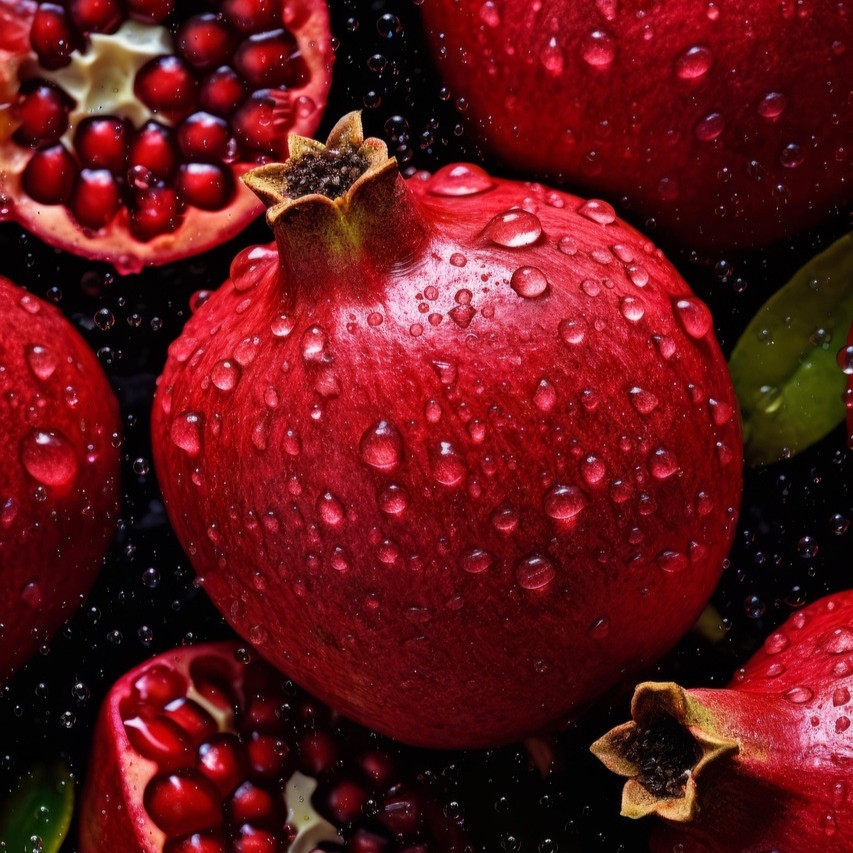Biological Engineering Student
Nutrition Student
Nutrition Student
Nutrition Student
Department of Chemical Engineering and Bioprocesses
Faculty of Medicine
Faculty of Medicine
Portada » Healthy Gummies from Pomegranate Peels: A Sustainable Innovation

Biological Engineering Student
Each time we peel a pomegranate , a fruit known for its vibrant color, sweet-tart flavor, and juicy seeds—we typically discard the peel without a second thought. However, this so-called “waste,” which often ends up in the trash, could actually be an incredibly valuable ingredient for both our health and the environment.
Pomegranate, a fruit native to Mediterranean-climate regions such as Northern Chile, generates a large amount of peel—almost half of its weight—that often goes unused. But did you know that this peel is packed with natural compounds that may combat aging, reduce inflammation, and even help prevent diseases?
In a world where we strive for healthier eating and a reduced environmental footprint, transforming byproducts like pomegranate peel into something valuable is an intriguing proposition. This seemingly waste material is rich in polyphenols—bioactive compounds known for their antioxidant, anti-inflammatory, and antibacterial properties.
These benefits motivated Bernardita La Fuente, a fourth-year Biological Engineering student, together with Nutrition students Javiera Ghione, Alexia Morales and Enyel Ruiz to explore their potential under the research of professors Wendy Franco, from the Department of Chemical Engineering and Bioprocesses and the School of Medicine, and Francisca Echeverría, from the School of Medicine. This research also counted with the collaboration of chef Sebastián Tobar.

Photograohy of Punica Granatum (pomegranate)
Together, they conducted research to harness the peel and turn it into a key ingredient for making tasty, healthy gummies—blending science, nutrition, and sustainability.
To extract the benefits of pomegranate peel, its bioactive compounds were carefully extracted from crushed peel using a mixture of water and ethanol—a low-toxicity alcohol. The solution was then concentrated using a rotary evaporator– a device that allows for the rapid and precise separation and concentration of substances, removing the alcohol from the mix in the process. The resulting extract was diluted in distilled water, creating what is known as Pomegranate Peel Extract (PPE).
The PPE was then analyzed, revealing a high concentration of polyphenols and antioxidants—compounds capable of neutralizing harmful substances in the body, such as free radicals. This suggests that incorporating the extract into our diets could offer substantial health benefits.
Next Came the creative part: making the gummies. This phase involved developing a simple yet healthy recipe using gelatin, raspberry pulp, citric acid (for that tangy kick), and allulose. Three versions of the gummies were prepared: one without the extract (as a control), one with 5% PPE, and another with 10% PPE. The aim was to determine whether the health benefits of pomegranate peel could be incorporated without compromising the flavor or texture typically found in gummies.
The gummies were tested both in the lab and by potential consumers. Chemically, the gummies with higher concentrations of PPE showed lower levels of carbohydrates and fats, but higher protein content—suggesting that pomegranate peel contributes beneficial nutrients to the diet. Furthermore, the antioxidant properties of the extract remained intact within the gummies, making them a “functional” snack that combines great taste with health benefits.
To assess their reception outside the lab, an organoleptic evaluation was conducted—this is a qualitative assessment of taste, color, texture, and overall acceptability—on a scale from 1 to 7, with the participation of 55 volunteers. While the gummies with PPE scored slightly lower, they were still comparable to traditional gummies, which surprised the research team. This suggests that adding an acidic and unconventional ingredient like PPE did not negatively impact the sensory experience for consumers. However, it was observed that as the amount of PPE increased, the gummies became more opaque, and the flavor became more intense—factors that could be adjusted in future formulations to make the gummies even more appealing.
Biological Engineering Student
Nutrition Student
Nutrition Student
Nutrition Student
Department of Chemical Engineering and Bioprocesses
Faculty of Medicine
Faculty of Medicine
Esta investigación realizada dentro del Programa de Investigación de Pregrado no solo confirmó el potencial de la cáscara de granada como fuente de compuestos bioactivos, sino que también exploró su transformación en un ingrediente clave para un producto atractivo y nutritivo. Las gomitas con ECG son una prueba de que se puede innovar en la cocina usando desechsomething particularly relevant in a country like Chile, where sustainability is an urgent concern. Although the gummies without the extract were more popular, the healthier versions showed a promising balance of health benefits and flavor, opening the door to further research and formulation adjustments to create the perfect product.
Moreover, this project invites us to reconsider the value of what we commonly discard. Thanks to the work of students like Bernardita, Javiera, Alexia, and Enyel, science is showing that it is possible to transform waste into solutions that benefit both health and the environment. It is a call for sustainable innovation and for exploring new ways to make more efficient use of our resources.

Biological Engineering Student